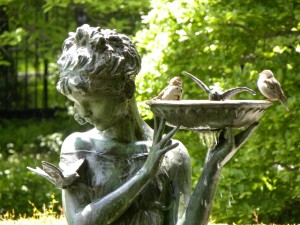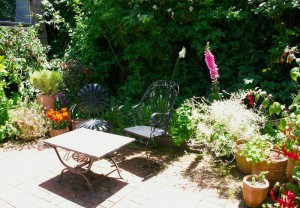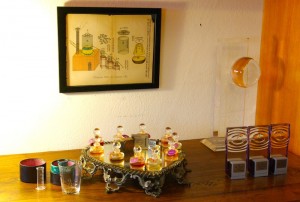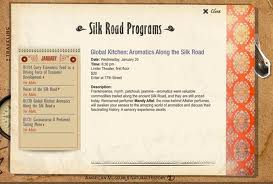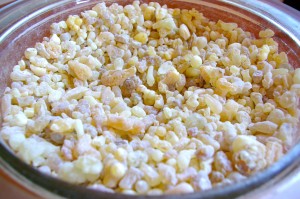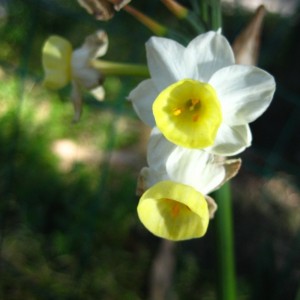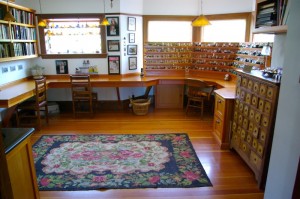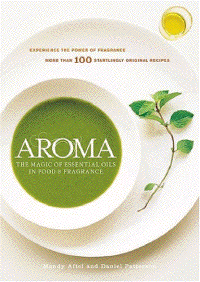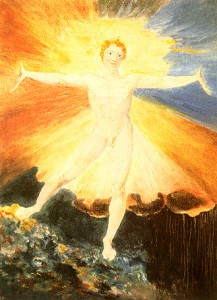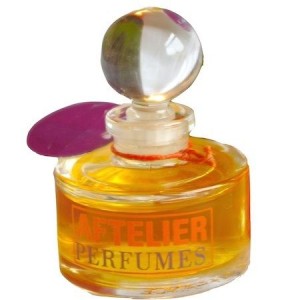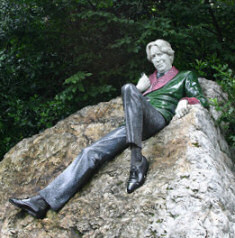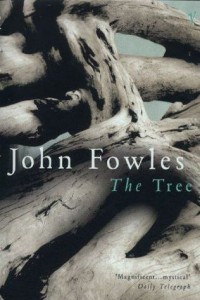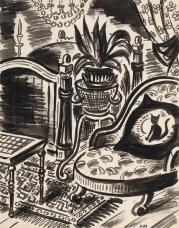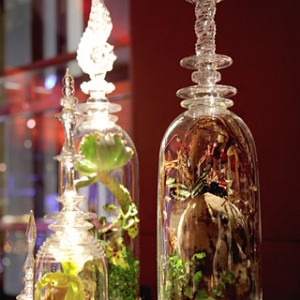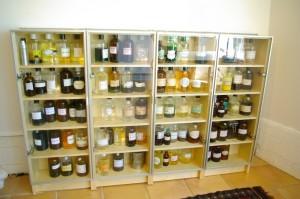Property of Mandy Aftel
There are many things you know about Mandy Aftel, the 3x Fragrance Foundation 2011 Awards Finalist and “the Mother” of Natural Perfumery. She speaks in front of thousands, revered by even more; but she is a private person who doesn’t like the spotlight shining on her; Mandy wants our readers to know she is actually quite shy. Instead of speaking about her philanthropy, her personal life and topical fragrance issues, she much rather that Cafleurebon give you a piece of her scented soul by inviting you to enter the place she calls home—which is also her Atelier- and where she lives a relatively quiet life with her husband, her much beloved plants, flowers … its her sanctuary, her refuge and the source of constant inspiration.
Central Park, NYC
I stopped searching Michelyn Camen and Mandy Aftel after 16 pages on Google. We have had a long and mutually enriching relationship; as I was the first mainstream journalist to interview you in 2007, dubbing you the Queen of Green. I know that my knowledge of natural perfumery began with you and changed my perception of fine fragrance .Does the recognition and growth of natural perfumery in 2011 surprise you?
Property of Mandy Aftel
MA: No it doesn’t surprise me, but it does make me very happy. I am so glad to see so many people embracing natural perfumery; I see people launching their lines and teaching others how to make perfume. Also, many people are just learning on their own, people who love the essential oils and find their way by teaching themselves. Now many blogs cover natural perfumes and bring attention to new and young perfumers – it was a dream of mine from the very beginning that there would be room for all-natural perfume in the marketplace, and I see that as actually taking place now.
Property of Mandy Aftel
I dubbed 2010 the year of natural perfumery. You were especially prolific. What were the many projects you worked on?
MA: I released several new perfumes and, of course, three of them were FiFi finalists. I completely redesigned my website. I gave talks at the American Museum of Natural History and the Bowers Museum about fragrance and the Spice Route. I put on the Alchemy of Taste and Smell at the Astor Center NYC with Harold McGee and chefs Daniel Patterson, Johnny Iuzinni, Wylie Dufresne, and David Chang among others. I joined Facebook and Twitter, which has been such a positive experience for me – to meet so many other perfumers, bloggers, and people who love perfume. I really love the interaction in this online community, being able to speak directly to the people who are interested in my work.
Property of Mandy Aftel
In your own words WHAT is natural perfumery?
MA: Natural perfumery is the art of creating beautiful luxury fragrances, using only natural essences. These botanical essences come from flowers, fruits, leaves, roots, and barks. Natural essences, unlike their synthetic counterparts, contain minute trace elements, which is why Moroccan rose smells different from Bulgarian rose or Egyptian rose.
I attended a lecture in 2010 at the Museum of Natural History that chronicled the art of natural perfumery, to a packed house. One question from the audience was regarding the use of synthetics in fragrance, which of course you do not use. Since then you seemed more open to sharing ideas with perfumers such as Andy Tauer. How did these exchanges help you in your creative process by using isolates
MA: Over the years, it has become more important to me that a perfumer is an artist and less important whether they use all-natural materials. It was a great joy to share the creative process with Andy . I admire him as a perfumer and the way that he has created his business. Working from the same initial essence with him––Linden Blossom CO2––allowed both of us to look into each other’s creative process. For me, always working in a solitary, intuitive way had meant that I never had to find the language to describe what I was doing, so it changed things internally for me to have to find the words and communicate to Andy and the readers of Nathan’s blog.
Mandy Aftel buries her nose in Hojary frankincense dailly!!! Property of M.Aftel
My work became more self-conscious because I knew I was going to have to explain it. And in that way I became more aware of my own creative process, I really enjoyed finding a greater intimacy with it. Even though the making of each perfume is different, I discovered some common aspects in my creative process that I had been unaware of.
As for natural isolates, I had already been using them for quite a while. Even among the natural sources of isolates, there is a wide variation in quality, so my job upfront – as usual – is to find the very best versions. The natural isolates are separated as part of the specialized extraction process, but beyond that they are similar to using other traditional essential oils. They add another facet to the perfumer’s palette – each one has to be studied for its own characteristics, but designing with them isn’t any harder than with other naturals.
Welcome! Property of Mandy .Aftel
Forbes magazine once named you one of the top seven bespoke perfumers’ in the world. Who are some of your clients and are they mostly celebrity or private clients?
MA: I have created custom perfumes for celebrities, but mostly they are created for my private clients. It is one of the things I enjoy doing most, and is based entirely on the client’s interaction with my collection of aromatic raw materials. I don’t use questionnaires and don’t ask any questions about the client’s life. But invariably, during their journey through the different essences, they tell me so much about their lives because the essences themselves are conduit to memories.
Who are some of the major chefs and restaurants that have used your Chef Essences. Please enclose a recipe from a top chef for our readers using your chef’s essences.
MA: I have supplied my Chef’s Essences to chefs and mixologists at a number of fine restaurants and bars, such as Jose Andrés, the White House, Jean Georges, Alinea, WD-50, Blue Hill, Coi, Pegu Club, PDT, Aldea, Mondrian Soho, Morgans Hotel, Clift Hotel, Michael Mina, and the Commonwealth Club. I want to share this wonderful recipe that Daniel Patterson wrote for our cookbook, Aroma – it’s a yogurt-based soufflé that uses my rose absolute and fresh ginger essential oil.
Rose and ginger soufflé
This soufflé is based on yogurt instead of the traditional pastry cream, which gives the soufflé incredible lightness, and adds a subtle tanginess. It is incredibly easy to make, and the aroma of the rose intermingled with the ginger is unforgettable.
The idea that soufflés need to be baked at a high temperature in order to achieve height is incorrect. Soufflés are best baked at a lower temperature because, like any protein, slower cooking allows the eggs to set more softly, creating a more delicate texture. The lightness of this soufflé makes it seem as if you are eating nothing but the pure aroma. Serves eight
unsalted butter, for buttering baking dishes
1 cup yogurt
1 cup egg whites
2 egg yolks
1 tablespoon blood orange juice (you can substitute regular orange juice)
¾ cup powdered sugar
10 drops rose absolute
13 drops fresh ginger essential oil
pinch of salt
Butter and sugar 8 4-ounce soufflé molds or ovenproof ceramic cups. In a mixing bowl combine the yogurt, egg yolks, blood orange juice and essences.
Preheat the oven to 325 degrees. In a mixer fitted with a whisk attachment, beat the whites on low speed with half of the sugar and a pinch of salt until they form soft peaks. Add the rest of the sugar and continue whisking until the whites form firm peaks. Carefully fold 1/3 of the whites into the yogurt base. Do not over-mix. Fold the rest of the whites until just combined and ladle into the soufflé molds. Fill the molds completely and then run your thumb around the top edge of the rim to create a slight indentation in the soufflé mixture. Bake until set but still moist inside, about 10 minutes. Serve hot in the soufflé molds.
One of my favorite fragrances is Lumiere, which you told me was one of the most difficult to achieve. One of our readers’ noticed that the top note is phenyl ethyl acetate– which is used in non-green products from anti-perspirant to fabric softener. How are you using it naturally (that is botanical and non-chemical).
MA: Natural isolates are not difficult to work with – just a logical extension of working with essential oils and absolutes. I was able to achieve that very translucent shimmering top note in Lumiere by using phenyl ethyl acetate. But more importantly I was looking for top note chord that would not overwhelm the incredibly beautiful and expensive boronia and blue lotus that make up a good part of the middle cord in Lumiere.
I was told by Chandler Burr that in 2012 natural perfumery will be included in MAD. If only one of your scents would make his curation, what is it and why.
MA: I would think Honey Blossom, because of the response I’ve gotten from many of my colleagues who are perfumers who find that Honey Blossom really opens their eyes to what a natural fragrance can do. I don’t necessarily see it as “typical” (if there is such a thing in natural fragrance) but I do think it would make a good bridge to someone who previously was not open to natural fragrances.
Historical Person you most admire?
MA: Oscar Wilde
Last book read?
MA: The Tree by John Fowles
Favorite painter?
MA: Franz Mazereel
Favorite vacation spot,,,
MA: Oaxaca, Mexico
Favorite quote?
MA: “All of us are in the gutter but some of us are looking at the stars”. (Oscar Wilde)
Property of Mandy Aftel
Any plans for home fragrance and soap products?
MA: I already created fragrances for soaps for Cleanwell. I don’t have plans for home fragrance or more soap products, but I do get asked regularly to do formulation jobs, and if one came along to do home fragrance or soap products I might be interested.
As a self-taught perfumer, with many years of experience, how gratifying is it when your students can fly on their own wings? Can you give an example?
MA: Well, I don’t buy into that model that some teachers do, of pushing little hatchlings out of my nest – that’s too much like thinking of them as kindergartners who have mastered their ABC’s and are going on to grammar school. The opportunities to learn are endless, so some of my advanced students keep coming back year after year. My students come in at a variety of levels, and leave more advanced, but they may have been flying just fine already. I do feel very glad for my students successes, for instance I’m gratified that Douglas Little (of D.L. and Company) counts me as a teacher, yet he was clearly already a terrifically creative and gifted artist on his own. I do not believe in creating a lineage of perfumers that are “certified” by some teaching method or another. In fact, many of the natural and artisanal perfumers I admire are self-taught, and often go on to teach others.
Property of M.Aftel
You have different ‘levels’ in you classes. Please explain?
MA: I teach perfume as an art, so the very small, hands-on, in-studio classes are definitely the key activity, where my students learn to critique and correct their own formulas for perfumes of at least 9 essences in alcohol. They are considered at Level 2 for the first 2 sessions (typically over a year), and then Level 3 for the next 2 sessions (over another year). To prepare for the in-studio class, students complete my basic Level 1 workbook, blending with up to 6 essences in oil. They complete these introductory, self-paced exercises on their own, to prepare for coming to study with me.
You told me you might be working on a new book. Can you discuss it?
MA: It is the sequel to Essence and Alchemy.
I didn’t know you during your first act as a psychotherapist and the author of Brain Jones of the Rolling Stones. I obviously know you during your ‘second act’. Is there a third act… what can we look forward to in 2011 and 2012?
MA: After two and half years of working on it, I am going to have my own perfume bottle and box that I designed. I am very excited about it! I am also creating two perfumes to be released in 2011
–Michelyn Camen, Editor in Chief
The photos of Mandy, her atelier, and garden are the property of Mandy Aftel. They are reserved for use only on CaFleureBon, to use ask Mandy for permission, but www.cafleurebon must be credited.
What is your favorite Aftelier Perfume? If Mandy could create a bespoke natural fragrance for you what would it smell like? Do you have a favorite natural ingredient?


